#northwest syria
Explore tagged Tumblr posts
Text
إدارة الصراع في شمال غرب سوريا وتأثيره على العلاقات التركية الروسية
إدارة الصراع في شمال غرب سوريا وتأثيره على العلاقات التركية الروسية إدارة الصراع في شمال غرب سوريا وتأثيره على العلاقات التركية الروسية الكاتب : غراف عبد الرزاق ملخص: يعد ملف إدارة الصراع في شمال غرب سوريا أحد أكثر الملفات تأثيرا على العلاقات التركية الروسية، وستحاول هذه الدراسة التطرق لمعضلة إدارة الصراع في شمال غرب سوريا من منظور الطرفين التركي الروسي، وذلك من خلال إبراز مواقف الطرفين تجاه…
#Conflict Management#northwest Syria#Russia#Turkey#Turkish-Russian relationships.#إدارة الصراع#العلاقات التركية الروسية#تركيا#روسيا#شمال غرب سوريا
0 notes
Text
Assad Loses Another Syrian City, Rebels March Towards Damascus: 10 Facts
New Delhi: In another setback to President Bashar al-Assad’s hold on power, the Syrian government forces have lost control of Daraa city, widely regarded as the birthplace of Syria’s 2011 civil uprising. Here Are 10 Points On this Big Story: In 2011, Daraa city, located roughly 100 km from capital Damascus, became the epicentre of nationwide protests after the Assad government detained and…
#al assad#bashar al-assad#Hama and Homs#HTS#Latakia#Middle east conflict#Middle East tensions#middle east war#northwest syria#Syria civil war#syria new#Syria news#Syria Rebels#Syria War#Syrian Civil War#Syrian Civil Wars#Syrian Crisis
0 notes
Text
إدارة الصراع في شمال غرب سوريا وتأثيره على العلاقات التركية الروسية
إدارة الصراع في شمال غرب سوريا وتأثيره على العلاقات التركية الروسية إدارة الصراع في شمال غرب سوريا وتأثيره على العلاقات التركية الروسية الكاتب : غراف عبد الرزاق الملخص: ملخص: يعد ملف إدارة الصراع في شمال غرب سوريا أحد أكثر الملفات تأثيرا على العلاقات التركية الروسية، وستحاول هذه الدراسة التطرق لمعضلة إدارة الصراع في شمال غرب سوريا من منظور الطرفين التركي الروسي، وذلك من خلال إبراز مواقف الطرفين…

View On WordPress
#Conflict management#northwest Syria#Russia#Turkey#Turkish-Russian relationships.#إدارة الصراع#العلاقات التركية الروسية#تركيا#روسيا#شمال غرب سوريا
0 notes
Text
إدارة الصراع في شمال غرب سوريا وتأثيره على العلاقات التركية الروسية
إدارة الصراع في شمال غرب سوريا وتأثيره على العلاقات التركية الروسية إدارة الصراع في شمال غرب سوريا وتأثيره على العلاقات التركية الروسية الكاتب : غراف عبد الرزاق الملخص: ملخص: يعد ملف إدارة الصراع في شمال غرب سوريا أحد أكثر الملفات تأثيرا على العلاقات التركية الروسية، وستحاول هذه الدراسة التطرق لمعضلة إدارة الصراع في شمال غرب سوريا من منظور الطرفين التركي الروسي، وذلك من خلال إبراز مواقف الطرفين…

View On WordPress
#Conflict management#northwest Syria#Russia#Turkey#Turkish-Russian relationships.#إدارة الصراع#العلاقات التركية الروسية#تركيا#روسيا#شمال غرب سوريا
0 notes
Text

2 notes
·
View notes
Text
The World Food Program announced it is ending general assistance to northwest Syria. Syrians get little aid in general and are at risk en mass of food insecurity.
Please consider donating to Islamic Relief so that they can distribute food and other materials.
28K notes
·
View notes
Text

The Death Toll of the Earthquake that hit Turkey and Syria may have reached 20,000 people, and that’s outside of all those who are injured and lost.
If you could donate PLEASE do!!!
Here’s a post full of charities you could donate to, but I’ll add my own trustworthy ones here:
Islamic Relief: teams are on the ground right now providing emergency food assistance, shelter, medical supplies to hospitals and clinics, as well as blankets and tents for those made homeless by the quake in Turkey and Syria
Molham: The team at Molham are currently on the ground helping displaced families in Turkey and Syria who have been affected by the earthquake
The White Helmets: The team are on the ground in Northwest Syria searching for survivors and removing the dead from the rubble.
MSF: remaining in close contact with the local authorities in northwestern Syria and with the authorities in Turkey to extend their support where it’s needed. They’re providing essential life kits to displaced people in the region
please PLEASE reblog. Syria and Turkiye need our help!!!
#signal boost#turkiye#turkey#syria#earthquake#earthquake 2023#turkey earthquake#syria earthquake#current events#natural disasters#important#charity#donations
24K notes
·
View notes
Text
Hi! My last donation post reached the 100 link limit so this is my new one. I'm going to work on getting individual lists for each cause and linking them here, so it's a bit more organized than the last one.
I have added a few new links, but for the time being, I am focusing on the campaigns I have listed. While I do not have the capacity to take on anymore campaigns, I will still reblog ones I see others post about to help share them.
I will do my best to keep the links updated with their progress.
DISCLAIMER: I do not vet fundraisers. I only share ones that have been vetted by others, vouched for, or are credible.
Palestine
Sudan
Congo
Tigray
Resources for Syria
Resources for Haiti
Hurricane Beryl Relief resources
Arab.org - Daily clicks
World Food Programme trivia game - play to generate donations
Links to more causes:
‼️ indicates that a fundraiser has experienced a decrease in donations or has been without donations for some time
The Levin House Child Foundation (gfm: £8,438/£35,000 - VERY low on funds)‼️
Uyghurs
Uyghur Human Rights Project
Static & Noise - Film and Advocacy
Free Uyghur Now
Foundation for Uyghur Freedom
List of ethical clothing brands
Haiti
P4H Global Education Development
P4H Canal Support
Hope for Haiti
Action Against Hunger
List of resources for Haiti made by @/hobiebrownies on twitter (places to donate, accounts to follow, news sources, and educational links)
Thread of gfms for Haiti
Startup Progression society art school Haïti (€2,756/5,000)‼️
Rohingya Refugees
Urgent Education Aid for Rohingya Refugee Students, organized by Rohingya Community Partners ($7,515/$15,000) STAGNANT FOR OVER A MONTH‼️
Emergency Relief for Rohingya Families, organized by The Rohingya Women's Network ($12,513 /$20,000 AUD)‼️
Qurbani Emergency Aid for Rohingya Refugees ($11,710/$12,000) STAGNANT FOR OVER TWO MONTHS‼️
Advocating for Peace and Building Hope: RCP Appeal, organized by Rohingya Community Partners (£18,760/£20,000)
Nigeria
Donate to the Humanitarian crisis in northwest Nigeria ($5,374/$15,000 CAD - VERY low on funds) ‼️
Medical and sanitary supplies to support women & children in Congo, Nigeria, and Sudan ($35/$3,000 CAD - VERY low on funds) STAGNANT FOR OVER TWO MONTHS‼️
Claire Aid Foundation
Action Against Hunger
Lebanon
Lebanese Red Cross
Supporting Africans Trapped in Lebanon ($33,454/40,000 CAD)‼️*shared by Sara (@/bsonblast)
Sultan and his family ($1,982/30,000 CAD)‼️
Donate to Beit el Baraka - select South Lebanon Aid for the "where to donate" list
Listed of vetted Lebanese fundraisers
#Palestine#free palestine#Gaza#Rafah#all eyes on rafah#sudan#eyes on sudan#darfur#el fashir#Democratic Republic of the Congo#drc#dr congo#Congo is bleeding#goma#m23 rebels#uyghur#uyghur genocide#uyghur muslims#haiti#free haiti#rohingya#rohingya refugees#myanmar#nigeria#niger delta#lebanon#lebanon aid#pinned post
381 notes
·
View notes
Text
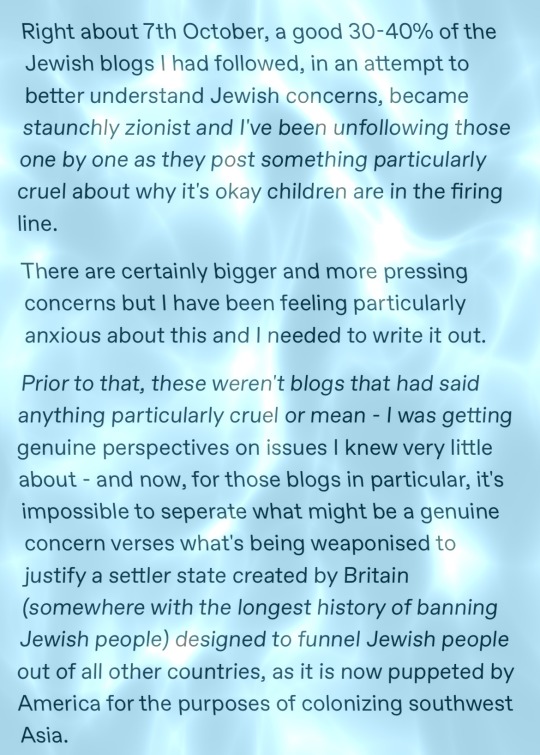
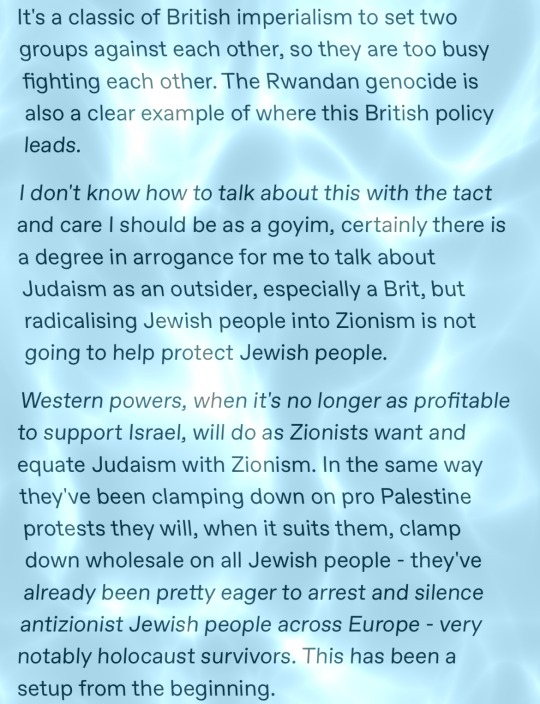

so this is a trashfire for many reasons.
lack of historical knowledge and complete lack of perspective
israel was not created by britain. israel declared independence from britain. israel was not "designed to funnel jewish people out of all other countries." israel is not "puppeted by america for the purposes of colonizing southwest asia" and the insinuation that israel's goal is to colonize the entirety of southwest asia is actually a documented antisemitic conspiracy theory.

"Even before the State of Israel came into existence, Arab leaders accused Zionists of seeking to rule most of the Middle East," a secret Jewish plot to establish a "Greater Israel" extending from the Nile to the Eurphrates and the Persian Gulf, and south deep into Saudi Arabia. Albeit "farfetched" and a "calumny," this notion has "become so routinized and accepted" that it "now serves as the conventional wisdom in all the Arabic-speaking countries and Iran." Pipes 1998, 49, 69. This is one of two maps in the collection alleged to provide evidence of the "Greater Israel" conspiracy. (The other is ID #2411, "Jewish Imperial Ambitions In Palestine and Neighbouring Countries," 1967.) This map, "Dream of Zionism," shows Zionism as a giant serpent, its back decorated with a pattern of triangles described as "Freemasons Eye, 'Symbol of Jewry.'" The snake's circular outline marks the "Proposed Boundary of 'Greater Israel,'" an area including all of Jordan, Lebanon, Syria, and the Sinai Peninsula; the Nile delta region of Egypt along the Suez Canal and northwest of Cairo; and virtually all of Iraq, including access to the Persian Gulf. It also includes a large portion of northwestern Saudi Arabia, a corridor well over 100 miles wide along the Red Sea, stretching south more than 450 miles from the Gulf of Aqaba to the Holy City of Medina. "Curiously," the conspiracy theorists "see Greater Israel including Medina but not Mecca; the oil fields of Kuwait but not those of Saudi Arabia; and more of Turkey than Iran." The State of Israel is identified as "Occupied Palestine." Pipes 62. This map first appeared in an English-language edition of the fraudulent "Protocols of the Elders of Zion" - the infamous blood libel against the Jewish people - published in Iran in 1985. Ibid. This version appears in a new edition, "Protocols of the Learned Elders of Zion," attributed to "The Representatives of Zion, of the 33rd Degree" and published in Kuwait by the "Scientific Research House." The estimated publication date is 2018. The current version of the map varies only slightly from that of 1985 illustrated in Pipes: the words "Symbol of Jewry" have been added in script beneath the legend "Freemasons Eye," and a partially legible signature ("Mir"?) appears at the lower right.
also i'm not sure what the intention was with bringing up the rwandan genocide because rwanda was colonized by germany and belgium, not the british. unless you think literally everything bad that happens in the world is tied to britain... which just so happens to be another antisemitic conspiracy theory that originated in the ussr. all the while jews were being demonized in the uk for being "communist sympathizers." because jews are the symbol of everything you hate, all the problems in your life. that is how antisemitism functions.
2. tokenizing jews for your own benefit
"i had followed [jewish blogs] in an attempt to better understand jewish concerns ... and i've been unfollowing them one by one ... i was getting genuine perspectives on issues i knew very little about - and now, for those blogs in particular, it's impossible to separate what might be a genuine concern verses wht's being weaponised to justify a settler state"
this is an open admission that you are only able to take in jewish perspectives from jews you agree with. and considering the ignorance that's rampant in the rest of the post, my guess is that what you saw was jews who were scared and angry at the way people acted after october 7th and the way antisemitism is rising, but the non jews you follow were insistent that those sentiments could not coexist with palestinian liberation. additionally, the fact you are unable to separate genuine concern verses "what's being weaponised" is your own problem, not ours. the way jewish pain is being downplayed, mocked, ignored, and demonized, the way people have insisted that any mourning for the victims of october 7th or concern for the hostages must be propaganda is antisemitic. and you are actively contributing to that, particularly by saying that western powers arresting people during protests "has been a setup from the beginning" with the very clear insinuation that it is "zionists" who are to blame for the setup.
3. you are really fucking entitled
you are a british goy (not a "goyim" btw, goy is singular, goyim is plural). you literally admitted that you "don't know how to talk about this with the tat and care [you] should be as a [non jew]" and that "certainly there is a degree in arrogance for [you] to talk about judaism as an outsider." and yet you wrote this whole post full of antisemitic conspiracy theories and antisemitic biases while claiming you know how to protect jewish people and while claiming that zionism is "the biggest danger to jewish people right now."
let us be very fucking clear. the biggest danger to jewish people right now is antisemites and the actions they choose to take, and the consequences of those actions.
you say that "if you tell the general public, who are very susceptible to the broader news cycle, that judaism and zionism is the same thing, they very well will be motivated to do antisemitic things, because they believe they are fighting zionism."
this has already happened and has been happening for decades. framing jews as zionists and demonizing zionism as a jewish ideology is not new. it happened all across swana, even before israel declared independence, including during the farhud which was a pogrom that occurred as part of the holocaust in iraq where jews were executed, beaten, and tens of thousands had to flee from government-sponsored persecution specifically and explicitly targeted at jews under the guise of "antizionism." it also happened in the ussr.
the desire to completely separate judaism from zionism as a jewish ideology is not out of concern for jews. zionism is a jewish ideology founded on one possible solution to global antisemitism, as an attempt to keep jews safe from constant persecution, ethnic cleansing, and genocide. it's not a solution you have to agree with, but trying to completely divorce it from judaism only opens the door for the very people you claim to be concerned about who will use zionism as an excuse to attack jews, as they have been for decades.
i have said it before and i'll say it again. zionism is one of the jewish answers to the question "what do we do with the jews?" historically, the answers gentiles have come up with have been "subjugate them, ethnically cleanse them, slaughter them, genocide them." so when you respond to that question of "what do we do with the jews?" with "i don't really care, but not that! and actually your jewish answer is what's causing this in the first place so really it's your fault!" it's kind of fucking bonkers to expect most jews to respond in any positive way. if you expect to have a productive conversation with zionist jews or with jews as a whole, you must present your own answer to "what do we do with the jews?" and if you're thinking "well how the fuck am i supposed to figure out a plan to get antisemitism all over the world to go away? that’s going to take too long!" you almost understand the point. the eradication of antisemitism is a global effort, and one that won't be achieved in our lifetimes. so the least you can do in the meantime is educate yourself, interact with jews in good faith, listen to jewish perspectives even if you don't agree with them, and realize that you are still going to have only scratched the surface.
so yes, you're right. it was extremely arrogant of you to post this, and you are an example of how ignorance breeds antisemitism among the uneducated masses.
135 notes
·
View notes
Text
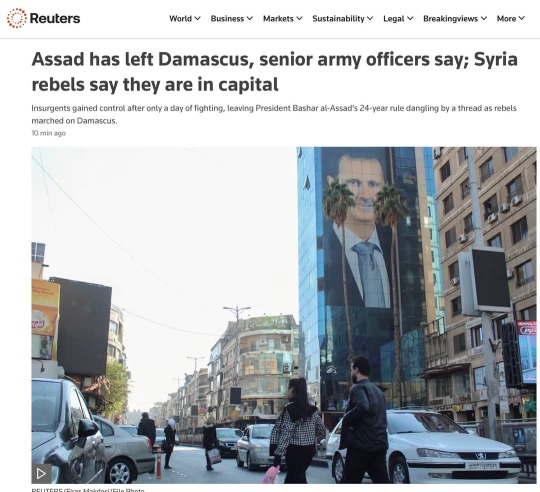
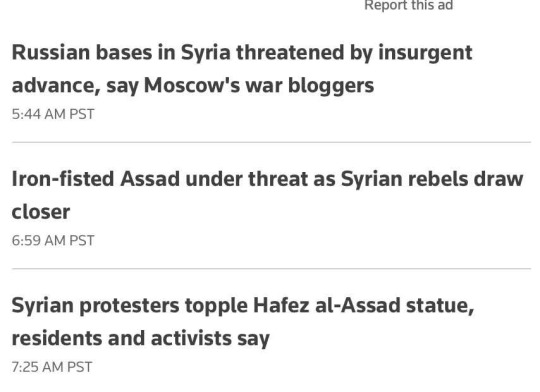
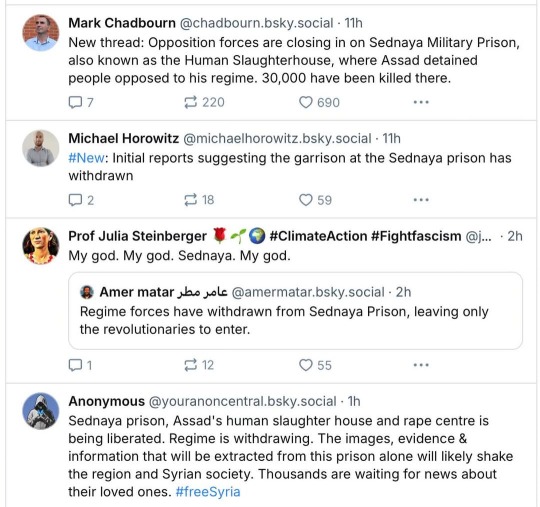

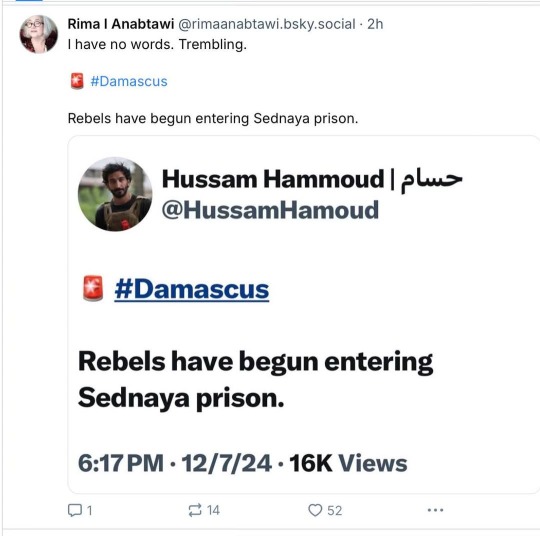
From Rebecca Solnit:
"My God. I was out all day today. Bashar Al Assad, the Butcher of Syria, has fled, his infamous prison/death camp/torture center has been freed, and rebels have taken Syria as far as I can tell. What a week. Insurrectionary Georgia. Coup-repelling South Korea. Now this.
The Guardian reports: When Islamist militants swept into her home town of Aleppo little over a week ago, Rama Alhalabi sheltered indoors as fear engulfed her. Forces loyal to president Bashar al-Assad, who had sought to reassure residents that nothing was happening, suddenly deserted the city. But as the insurgency pushed south, rapidly seizing control of the city of Hama on the road to Damascus, Alhalabi’s fears about life under militia rule have slowly ebbed. Instead they have been replaced by fears that her friends in the army will be abandoned by their commanding officers as Assad’s regime loses its grip.
“People in Aleppo are feeling more comfortable now we’re further from the areas under the regime’s control,” said the 29-year-old, while still using a pseudonym in fear Assad could retake the city.
“At the same time, I have many friends serving in the army and I don’t want them to get hurt. People with power inside the regime will protect themselves, and they will leave the poor fighters who were forced to join the army to face their awful fate alone.
“Things changed insanely fast,” she added. “We can barely believe what’s happening.”
As militants spearheaded by the group Hayat Tahrir al-Sham (HTS) massed outside the city of Homs and rebel forces said they had entered the vast southern suburbs of the capital, rapid change swept across Syria. The Syrian army declared it had “redeployed,” its forces in two restive provinces south of Damascus in the latest thinly-veiled message of retreat, days after they withdrew from Hama. In under a week, five provincial capitals across the country were suddenly no longer under Assad’s control.
“We can hear the bombing nearby, and we are praying, hoping – and waiting,” said Um Ahmad, an elderly native of Homs, sheltering with her husband at home as the fighting drew close enough to be audible.
Assad loyalists fled the city, while people who stayed only have a couple of hours’ electricity each day and what goods are left in the shops are unaffordable. Those remaining in Homs waited to see if this might be the end of Assad’s rule, while an insurgent commander told his regime’s forces inside the city that this was their “last chance to defect before it’s too late”.
Um Ahmad was consumed by a single thought, that she might finally be able to see her sons again after a decade of separation and exile. “Most people are frightened but they fear the regime’s revenge more than anything else,” she said, as Russian and Syrian airstrikes pummelled the countryside around Homs and Hama.
When a popular uprising swept cities across Syria in 2011 calling for Assad to go, it initially looked as if demonstrations could topple another regional autocrat. But the Syrian leader swiftly turned the state’s weapons on his own people to crush dissent. As the uprising slowly morphed into a civil war, Assad freed jihadist prisoners from his fearsome detention system to alter the forces rising up against him, before relying heavily on his allies in Russia and Iran to provide the military muscle he used to reclaim control.
The civil war killed over 300,000 people in 10 years of fighting, with some estimates putting the true toll at twice that number. Tens of thousands remain in detention, including 100,000 believed missing or forcibly disappeared in Assad’s prisons since 2011, and subject to what United Nations monitors have described as systematic torture. Over 12 million people have been displaced.
Assad kept control of Syria’s major cities for years, as battle lines from the country’s years-long proxy war hardened. HTS ruled over a mountainous pocket in the northwest, cut off from the outside world. The group appeared a dim threat to Assad until they suddenly launched an offensive that saw them take control of Aleppo within days.
https://www.theguardian.com/world/2024/dec/07/syria-assad-damascus-hayat-tahrir-al-sham-insurgents
42 notes
·
View notes
Text
Climate change-driven heatwaves threaten millions

Extreme record-breaking heat leads to severe crises across the world.
Already in 2024, from Israel, Palestine, Lebanon, and Syria in the West; to Myanmar, Thailand, Vietnam, China, and the Philippines in the East; large regions of Asia are experiencing temperatures well above 40°C (104°F) for days on end.
The heatwave has been particularly difficult for people living in refugee camps and informal housing, as well as for unhoused people and outdoor workers.
Using the Heat Index Calculator, at that temperature and a relative humidity of 50%, residents see a heat index of 55°C (131°F) - a temperature level humans cannot long survive:

In February, the southern coastal zone of West Africa also experienced abnormal early-season heat. A combination of high temperatures and humid air resulted in average heat index values of about 50°C (122°F) - the danger level, associated with a high risk of heat cramps and heat exhaustion.
Locally, temperatures entered the extreme danger level associated with high risk of heat stroke, with values up to 60°C (140°F):

Even here at Ad Astra's HQ in Kansas, last summer we saw several days with high temperatures of 102°F (39°C) at 57% humidity, resulting in a heat index of 133°F (56°C):
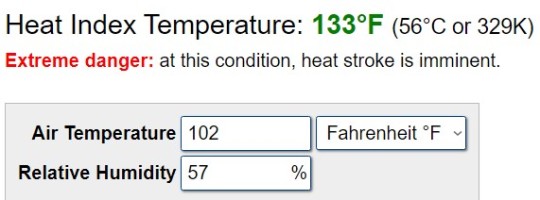
Of course, the major difference in survivability in Kansas versus some of the places suffering extreme heat right now is that air-conditioning abounds here. Those who live somewhere that faces extreme heat but can escape it indoors are a lot more likely to survive, but a person who lives somewhere without such life-saving gear faces not just discomfort, but heat stroke and even death.
This includes unhoused and poor people here in the wealthier parts of the world, who often do not have access to indoor refuge from the heat.
About 15% of US residents live below the poverty line. Many low-wage earners work outside in construction or landscaping, exposed to the ravages of heat. Many do not own an air conditioner, and those who do might need to budget their body's recovery from heat against cost to purchase and run cooling equipment. Because heat stress is cumulative, when they go to work the next day, they’re more likely to suffer from heat illness.
Bad as that is, for those living on the street, heatwaves are merciless killers. Around the country, heat contributes to some 1,500 deaths annually, and advocates estimate about half of those people are homeless. In general, unhoused people are 200 times more likely to die from heat-related causes than sheltered individuals.
For example, in 2022, a record 425 people died from heat in the greater Phoenix metro area. Of the 320 deaths for which the victim’s living situation is known, more than half (178) were homeless. In 2023, Texans experienced the hottest summer since 2011, with an average temperature of 85.3°F (30°C) degrees between June and the end of August. Some cities in Texas experienced more than 40 days of 100°F (38°C) or higher weather. This extreme heat led to 334 heat-related deaths, the highest number in Texas history and twice as many as in 2011.
The Pacific Northwest of Canada and the USA suffered an extreme heat event in June, 2021, during which 619 people died. Many locations broke all-time temperature records by more than 5°C, with a new record-high temperature of 49.6°C (121°F). This is a region ill-suited to such weather, and despite having relatively high wealth compared to much of the world, many homes and businesses there do not have air-conditioning due to a history of much lower temperatures.
Heatwaves are arguably the deadliest type of extreme weather event because of their wide impact. While heatwave death tolls are often underreported, hundreds of deaths from the February heatwave were reported in the affected countries, including Bangladesh, India, Thailand, Myanmar, Cambodia, and the Philippines.
Extreme heat also has a powerful impact on agriculture, causing crop damage and reduced yields. It also impacts education, with holidays having to be extended and schools closing, affecting millions of students - in Delhi, India, schools shut early this week for summer when temperatures soared to 47°C (117°F) at dangerous humidity levels:
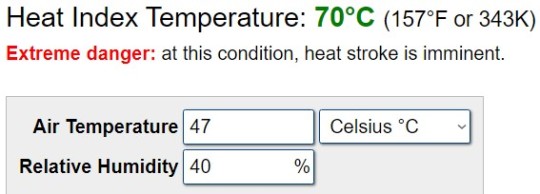
At 70°C (157°F !), humans simply cannot function and face imminent death, especially when humidity is high. This is the notion of "heat index," a derivative of "wet-bulb temperature."
Though now mostly calculated using heat and humidity readings, wet-bulb temperature was originally measured by putting a wet cloth over a thermometer and exposing it to the air.
This allowed it to measure how quickly the water evaporated off the cloth, representing sweat evaporating off skin.
The theorized human survival limit has long been 35°C (95°F) wet-bulb temperature, based on 35°C dry heat at 100% humidity - or 46°C (115°F) at 50% humidity. To test this limit, researchers at Pennsylvania State University measured the core temperatures of young, healthy people inside a heat chamber.
They found that participants reached their "critical environmental limit" - when their body could not stop the core temperature from continuing to rise – at 30.6°C wet bulb temperature, well below what was previously theorized. That web-bulb temperature parallels a 47°C (117°F) heat index.
The team estimates that it takes between 5-7 hours before such conditions reach "really, really dangerous core temperatures."
youtube
On March 5, 2024, Hong Kong saw temperatures of 27°C (80°F) with 100% humidity, which results in a heat index of 32.2°C (90°F) - seemingly not so bad until considering it's higher than the critical wet-bulb temperature. Also, if you watch the video, imagine the long-term effects of water accumulating in residences, such as dangerous mold.
We are witnessing the effects of climate change right now, all around the world, and rising temperatures are just the most-obvious (what we used to call "global warming"). Many, many other side-effects of climate change are beginning to plague us or headed our way soon, and will affect us all.
Unfortunately, those most affected - and those being hit the hardest right now - are people most vulnerable to heatwaves. With climate crises increasing in both intensity and frequency, and poverty at dangerous levels, we face a rapidly rising, worldwide crisis.
We must recognize the climate crisis as an international emergency and treat it as such. So much time, creative energy, resources, and life is wasted in war and the pursuit of profit or power - consider how much good could come from re-allocating those resources to ensuring a future for Earthlings, instead.
(Expect to see a "Science into Fiction" workshop on climate change coming soon - SF writers have a particular responsibility to address such important topics of change and global consequence.)
#climate crisis#climate change#global warming#heatwaves#poverty and homelessness#climate emergency#in response to asks for a post on this topic#stay tuned for posts on other crises arising from climate change
105 notes
·
View notes
Text
The Settler Violence You Don’t Hear About
We all know about the Turkish occupation of Cyprus and the hundreds of thousands of Turkish settlers living there since the Turkish invasion and occupation of part of the island in 1974. Actually no, most people have never heard about the illegal Turkish settlement of Cyprus, but that’s a subject for a different story. I want to talk about a more recent Turkish illegal settlement, one that is both ongoing and far more severe.
In June 2024, while Turkey was frothing at the mouth about the treatment of Arabs in "Occupied Palestine" – that is, Israel – Syrian refugees, also Arabs, were being lynched in Turkey for allegedly harassing a Turkish child. This was nothing new. According to EuroMed Rights, this was "yet another example in a series of anti-refugee discontent and violence. Turkey has previously experienced waves of lynching and attacks against refugees in 2014, 2017, and 2019, alongside individual offences that often go unpunished due to a pervasive culture of impunity."
However, this time the Arabs didn’t take this lying down.
Syrian militias allied with Turkey launched several attacks against Turks in Turkish-occupied northern Syria, resulting in Turkish fatalities. This is where it gets interesting, so let’s talk about this occupation for a little bit.
The Turkish-occupied region of Syria is around one-third larger than the West Bank and is rife with human rights abuses that are simply ignored by the Western media. In fact, in 2021 the NYT was accused by Kurdish and international activists of whitewashing Turkey’s occupation…which I bet you didn’t hear about either.
In 2018, Turkey invaded the majority-Kurdish Afrin District of northwest Syria ostensibly to prevent Kurdish attacks against Turkey in what was ironically called “Operation Olive Branch.” To quote Turkish President Recep Tayyip Erdoğan, "What can that terror army target but Turkey? Our mission is to strangle it before it's even born." So, very proactive self-defense.

Kurdish refugees leaving Afrin in Northern Syria
As many as 510 civilians were killed in the operation. Other atrocities included the mutilation of a female corpse by Turkey's Syrian National Army proxies, indiscriminate bombardment of civilians by Turkish forces, and shooting of refugees fleeing into Turkey.
However, the worst was yet to come. After Turkish-led forces had captured the Afrin District in 2018, they engaged in a wide resettlement program that included moving Arab settlers from southern Syria into homes that belonged to the displaced Kurdish and Yazidi locals. The previous owners were then prevented from returning to Afrin to reclaim their stolen homes. This wasn’t a chaotic process but a conscious ethnic replacement by the Turkish government and its SNA proxies.

Al Amal 2, one of the Arab settlements build in Afrin.
Paragraph 47 of the report of the Independent International Commission of Inquiry on the Syrian Arab Republic submitted to the UN Human Rights Council noted that "multiple accounts indicate that the property of Kurdish owners was looted and appropriated by Syrian National Army members in a coordinated manner. For example, in September 2019, civilians in the Shaykh al-Hadid subdistrict (of the Afrin region) described how members of Division 14, Brigade 142 (the Suleiman Shah Brigade) of the Syrian National Army had gone from door to door instructing Kurdish families with fewer than three members to vacate their houses to accommodate individuals arriving from outside of Afrin." It was also reported by Al-Monitor and Arab News that Yazidi and Kurdish women and girls have been kidnapped by the SNA for ransom, rape, or forced marriage. It stands to reason this was also done to “encourage” Kurds to leave the region.
Following the Turkish invasion, as many as 200,000 indigenous Kurds and Yazidis fled from the Afrin District while an estimated 458,000 settlers moved into their homes. According to a GenocideWatch article from 2020, the size of the indigenous population of Kurds in the Afrin region dropped from 97 percent before the occupation to 34.8 percent.
This is an ongoing process. According to a report by the Hawar News Agency from 2024, “Within the aim of separating Afrin from Syria and annexing it, the Turkish occupation continues to commit crimes, intimidate the people, and trade in their property by Turkey's settlers and mercenaries. Local sources said that a settler from the southern Aleppo countryside sold a house belonging to the citizen Issam Hussein, a resident of the village of Andariyah, in the city of Janders to another settler for $1,500.”
But wait, this gets even crazier!
Many of these settlers are Palestinians.
That’s right. Even as you read these lines, illegal Palestinian settlers are moving from the West Bank into stolen Kurdish homes in an occupied region, displacing and replacing the indigenous population… and they’re proud of it!
According to a 2022 article from the Afrin Post, “the first part of a residential community constructed in Jindires district was opened, with direct funding from the residents of Al-Zaeem village in the occupied city of Jerusalem. The project plan consists of 75 housing units, each of which consists of 4 houses, to accommodate about 220 families. Today, 32 housing units (about 128 families) have been settled in, while work is underway and preparations are being completed to start the second part of the project.”

"Funded by Al Zaim donations, in Quds Town.”
According to exiled Kurdish politician Abdulrahman Apo, all the villages of Afrin have been “turned into settlements. In addition to Syrian Arabs, 10,000 Palestinians are stationed in Afrin.”
A spokesman for one of the Palestinian settlements said, "Today, we arrived from Palestine to the airport, and from there to northern Syria, to deliver the housing units… [We] know the meaning of occupation, displacement, asylum and home displacement."
He sure does! He’s actively engaged in it! He’s doing exactly what the Palestinians falsely accuse Israel of doing, only on steroids.
In just a few years, more than 100 settlements have been built by Turkey and funded by Gulf countries and Palestinian associations in areas under Turkey’s control. In fact, one of the settlements is even called “Palestine Ajnadine.”
What can I say? The man is a master of irony, almost as much as the genius who called the whole thing "Operation Olive Branch."
Western liberals make so much noise about Israel, they silence the screams and pleas of tens of millions of victims of severe and ongoing human right abuses all over the planet. This obsessive tunnel vision creates the ultimate smokescreen for a plethora of atrocities that dwarf anything Israel may be involved in. Be honest, I’m sure you’ve never heard about Palestinian settlements on Kurdish land before you read this article. Why would you? Western media never talks about it. Western intellectuals never talk about it. It seems no one cares about it except the Kurds themselves.
This obfuscation by fake moral outrage is a big reason for Turkey’s ostensible obsession with Gaza. It’s less their concern for the Palestinians or objection to settlements, and more their desire to distract from their own ongoing crimes. I’m sure the Kurds, as well as the Greeks, Cypriots, Syrians, and other nations colonized by Turkey, would appreciate it, if Western liberals could spare some of their moral outrage for the occupation and colonization of these nations.
URI KURLIANCHIK
DEC 3
39 notes
·
View notes
Photo

Paul's Journeys and the Mediterranean Trade
Mediterranean trade increased exponentially at the turn of the first millennium. During Rome's zenith, goods of all sorts began to move in all directions. As a common traveler aboard merchant ships, Paul traveled within such a milieu. Tracing the water portion of his journeys in the New Testament can shed light on general trade patterns in the Mediterranean Sea areas.
Exotic Animal Transportation, Villa del Casale
Unknown Artist (Public Domain)
Trade at the Turn of the Millennium
As the Roman Republic in the latter centuries of the last millennium BCE began to conquer the littoral nations around the Mediterranean – including Europe, Northwest Africa, and Anatolia, the Mediterranean Sea indeed became, to the Romans, Mare Nostrum, "our sea." Then, with Rome's takeover of Syria, Phoenicia, and Egypt, by the time of Paul the Apostle, Rome's encirclement of control was complete. Rome became the main market for agricultural, material, and refined goods that, as a result, moved largely from East to West. Then, as the extent of the Roman Empire grew, followed by the colonization and urbanization of its eastern provinces, the empire's eastern half began to develop a degree of commercial autonomy that created an interactive network of activity.
Around 200 BCE, goods from the East moved through Mesopotamia to the Levant and Anatolia by overland routes from India and by water up the Persian Gulf, which was then taken by camel to Seleucia, near modern-day Bagdad. Another route in the Eastern trade network of ancient Rome was goods sailing from the northwestern ports of India to Alexandria via the Red Sea. However, by the early Augustan period, with Rome's eventual control of Arabia and the Red Sea, there began a dramatic increase in Eastern items moving west to Rome, including silks, decorated cotton, shells, tortoiseshell, coral, ivory, nard, aloe, frankincense, myrrh, and spices like pepper, cinnamon and cassia.
Adding to Rome's consumption, with 300,000 veterans of the Roman army to find land for, Augustus (r. 27 BCE to 14 CE) established 75 colonies throughout the empire. According to Nigel Rodgers, "All these generally small settlements – usually a couple of thousand veterans, growing perhaps into a city of 10-15,000 – helped the urbanization and Romanization of the empire" (87). Additionally, as the eastern Roman provinces began to mirror Rome in structure and taste, demand for the same goods increased. Those goods would, therefore, begin to travel not just west to Rome but were manufactured and traded in all directions. It was this commercial environment in which the journeys of Paul the Apostle took place.
Continue reading...
26 notes
·
View notes
Link
Donate Money to Global Relief Agencies
1. Doctors Without Borders/Médecins Sans Frontières (MSF)
MSF is an international, independent organization that provides medical assistance to people affected by disasters such as the Syria-Turkey earthquake.
On the ground, they are treating patients in their supported hospitals, and their teams have donated emergency medical kits to other facilities in the region. Find out more and donate now.
2. Syrian American Medical Society (SAMS)
SAMS is a global medical relief organization that works on the front lines of crisis relief to save lives. They are providing urgent medical care to the injured at Bab Al Hawa hospital among others. Donate now.
3. Union of Medical Relief and Care Organizations (UOSSM)
The UOSSM, which provides emergency medical relief and health care services to Syrian people, made an urgent appeal for assistance on Monday morning.
“The news we are seeing is terrifying and heartbreaking,” said Dr. Khaula Sawah, the president of UOSSM in the US, in a statement. “We know building infrastructures in Syria have already been compromised from years of bombing campaigns. We need urgent aid immediately so we can help save the lives of those injured in this massive earthquake. Our staff is working tirelessly but are overwhelmed with the numbers of casualties. We need urgent support immediately. Countless lives are at stake.”
Donate now.
4. Save the Children
In North West Syria, Save the Children is working closely with partner organizations to assess the scale of the damage to provide support that children desperately need as the situation becomes clearer.
In Turkey, they are working to assess needs and have established a response team which will be supporting the national emergency response across the region, in close coordination with the government, and key stakeholders. Save the Children's teams on the ground are planning to support affected communities with winterization and emergency kits, including blankets, and winter clothing. They are asking supporters to donate to their Children’s Emergency fund.
5. CARE International
Social justice organization CARE International is assessing the most urgent needs to help in the emergency response. Donate now.
6. Project HOPE
Project HOPE — the global health and humanitarian aid organization — has deployed emergency response teams in response to the earthquakes.
"The earthquakes that struck Türkiye and Syria this morning have already claimed thousands of lives and we anticipate a very arduous and long road to recovery ahead, including search and rescue efforts, health system reconstruction, and mass displacement,” said Rabih Torbay, Project HOPE’s President and CEO. “As temperatures hover near freezing and airport closures and snowstorms delay access, Project HOPE has deployed an emergency response effort and is working with local and international partners to respond to the immediate needs.”
Send hope to survivors by donating now.
7. UNICEF
In Aleppo, UNICEF is assessing with their partners and facilitators the situation across the governorate, including hard to reach and not government-controlled areas.
The initial focus is on water (assessing the impact on main water stations and interruption or damages in services, and getting water to those who have been displaced), child protection (assessing separated and unaccompanied children), nutrition, and education (assessing the damages in schools and whether schools are being used as shelter). Donate now.
8. International Medical Corps
International Medical Corps has already mobilized a response, deploying mobile medical teams in Syria to provide emergency medical care to people in the region affected by the quake.
They told Global Citizen: "We also are working with local partners in Turkey to respond, and are in discussion with the World Health Organization regarding a potential deployment of our Emergency Medical Team." Support their work now.
9. Oxfam
Oxfam KEDV, the Oxfam affiliate in Turkey, has partnerships with around 80 women’s cooperatives in 10 Turkish provinces most affected by the quake and is currently assessing response plans with them given the scale of devastation. Make a contribution.
10. Humanity & Inclusion
Nobel Peace Prize-winning organization, Humanity & Inclusion, is working on an inclusive emergency response, with a particular focus on people with injuries and disabilities.
Their Head of Mission for Syria, Myriam Abord-Hugon, says: "We expect a huge need for rehabilitation. There are thousands of injured people, and many of these injuries may worsen or turn into permanent disabilities if they do not receive appropriate rehabilitation services."
Send aid to earthquake survivors.
11. International Organization for Migration
The IOM is the principal UN agency working in the field of migration. Their teams are coordinating with governments and partners to respond to the needs of those affected, and ready to support with lifesaving support. Donate now.
Donate to Turkish and Syrian Humanitarian Organizations
12. IHH
The IHH Humanitarian Relief Foundation is a Turkish NGO that provides humanitarian relief in areas of war, earthquake, hunger, and conflict. They are preparing emergency food bundles for those affected. Donate now.
13. The White Helmets
The White Helmets is a grassroots team of volunteers across Syria who are supporting the urgent response. Give what you can to support their life-saving work.
14. NuDay
NuDay is a nonprofit working to secure dignified and empowered aid for women and children affected by humanitarian crises worldwide. Their team is on the ground, responding with emergency aid. Donate now via GlobalGiving (one of Global Citizen's partners) to help them reach vulnerable women and children with life-saving support.
15. Ahbap
Ahbap is a Turkish NGO that aims to provide all kinds of aid to those in need. This is their donations page.
16. AKUT
AKUT Search and Rescue Association is a Turkish NGO for disaster search and rescue relief. It was established in 1995 as a grassroots organization by seven leading outdoor athletes of Turkey. They are on the ground helping to rescue people from the rubble. Donate now.
17. Give Blood
Alarmingly, blood reserves in Turkey had already fallen below the minimum level of 50,000 to only 35,000 units in January 2023. If you’re based in Turkey, consider giving blood via the Turkish Red Crescent. Find a donation center near you.
18. Let People Know Where to Find Safety
A map has been created and is being constantly updated with the institutions and businesses that have opened their doors to citizens who have had to leave their homes after the earthquake. Share the map.
19. Raise Awareness
If you can’t donate at this time but want to help, consider sharing this article with friends, family, or on your social media accounts — it could well end up in front of someone who is in a position to support the relief effort financially.
349 notes
·
View notes
Text
Syrian President Bashar al-Assad faces the most substantial threat to his regime in years, after rebels captured Aleppo—one of the country’s largest cities—last week, along with dozens of other towns and villages, in a surprise assault.
The move on Aleppo followed a Nov. 27 offensive by Hayat Tahrir al-Sham (HTS), an opposition militant group and former al Qaeda affiliate that controls much of Syria’s Idlib province, which borders Aleppo province. Aided by locally manufactured kamikaze drones, HTS appears to have caught Assad’s forces off guard, prompting them to retreat from vast areas that are now under the group’s control. Both sides have already suffered significant losses, with at least 446 combatants and civilians killed since Nov. 27, according to the Syrian Observatory for Human Rights.
More than 14,000 people have been displaced due to the recent violence, according to local aid group Violet. But, for the first time in eight years, many regime dissidents are returning to towns and villages that are now under HTS control.
The Syrian civil war began in 2011 after Assad’s regime violently repressed pro-democracy protesters, triggering a conflict that has so far claimed more than half a million lives and displaced over 7 million people. Aleppo was a major opposition stronghold until 2016, when a Russian air bombing campaign retook the city for the Assad regime.
HTS leader Abu Mohammed al-Jolani has instructed his fighters to protect all civilians, including Christians, as well as Syrian regime soldiers who surrender, according to Idlib-based journalist Fared al-Mahlool. Following its split with al Qaeda around 8 years ago, HTS has sought to rebrand itself as a more moderate force than its erstwhile benefactor. Now, many residents of newly captured areas are uncertain what life under HTS control might entail.
Recent escalations in northwest Syria come as Assad’s main international supporters are preoccupied with their own conflicts. Russia is prioritizing its war in Ukraine, and both Iran and its proxy Hezbollah, in Lebanon, have been significantly weakened in fighting with Israel. Still, Russian and Syrian airstrikes targeted Idlib and Aleppo provinces over the weekend, while Iranian-backed militias from Iraq—including Kataib Hezbollah and Fatemiyoun—recently crossed into Syria, according to Al Arabiya, a Saudi Arabian news channel.
“Since Sunday, the bombings are constant,” Mahlool said. “Several schools and clinics in Idlib province have already been targeted.”
On Dec. 1, an airstrike hit Aleppo University Hospital, killing at least 12 people and injuring dozens more. The strike also damaged one of Violet’s ambulances, said Yemn Sayed Issa, the media and communication coordinator with the aid group. That same day, airstrikes targeted Idlib University Hospital, Ibn Sina Hospital, Idlib’s National Hospital, and the Idlib Health Directorate. And, according to Issa, a Soviet-era warplane struck a camp for displaced people near Ma’arrat Misrin, a town just north of central Idlib, killing at least seven civilians, including five children and two women. Violet’s medical team is responding to the attacks.
“It’s extremely dangerous for everyone. Our medics and ambulances head out daily, but constantly fear being targeted,” Issa said, adding that Aleppo—home to around 2 million people—is now critically short on essentials like bread, water, fuel, and medical supplies, which had previously been shipped from other regime-held areas.
“Everything is coming from Idlib now, but it’s difficult. The humanitarian situation is tragic. People are having to find shelter wherever they can,” Issa said. “In the town of [Darkush], for example, a public swimming pool has been turned into a temporary shelter for people who have fled their villages. Most displaced families have been forced to seek shelter in open fields and farmland, without any proper shelter or basic facilities.”
HTS’s advance means Aleppo is under opposition control for the first time in eight years. The front line had remained frozen since Russia and Turkey brokered a cease-fire deal in 2020. The two countries back opposing sides in Syria.
Russia, along with Iran and Hezbollah, are Assad’s key allies, while Turkey supports the Syrian National Army (SNA), a coalition of opposition groups—excluding HTS—that fights the Assad regime and Kurdish forces such as the People’s Defense Units (YPG) and the Kurdistan Workers’ Party (PKK). Turkey considers the latter two groups to be terrorist organizations.
Since the recent rebel offensive, Assad’s regime has effectively abandoned areas within Aleppo province and left them under Kurdish control. The SNA continues to push the Kurdish groups further east. On Dec. 1, the SNA captured the strategic town of Tel Rifaat, which is located between Aleppo and the Turkish border. For the past eight years, the area had been under YPG and PKK control—a significant national security concern for Turkey.
The relationship between HTS and the SNA has long been tense; HTS has sought control over SNA-held areas and the SNA distrusts HTS for numerous reasons, including ideological differences. But both groups share a common goal.
“The priority is to fight the regime,” said Orwa Ajjoub, a doctoral candidate at Malmo University in Sweden who researches Islamist groups in Syria. “I’ve spoken with people who are sworn enemies of HTS to this day, but now they’re putting their differences aside to fight the regime. HTS is leading these efforts. When the dust settles, we’ll see how these diverse groups manage to resolve their disagreements.”
Turkey has its own troops in Syria, primarily in Idlib, Afrin, and other areas east of the Euphrates River, mainly as part of its operations against the PKK and YPG. Around 900 U.S. troops are also in the country; mostly concentrated in northeastern Syria, they support counter-terrorism operations against the Islamic State.
Analysts have speculated over whether Turkey—which is keen to reduce the power of the PKK and YPG—gave HTS the green light for the operation. Turkish Foreign Minister Hakan Fidan, however, said that it would be “wrong” to try to chalk the current situation in Syria up to external intervention.
Turkish President Recep Tayyip Erdogan tried to mend relations with Assad in July, following a deterioration of ties throughout the war. Yet Assad insisted that Turkish forces must fully withdraw from Syria for him to negotiate with Erdogan—a request Turkey is unwilling to meet due to its own national security concerns.
Speaking with U.S. Secretary of State Antony Blinken on Dec. 1, Fidan stressed that Turkey opposes instability in the region and reiterated the importance of reducing tensions in Syria. Iranian Foreign Minister Abbas Araghchi arrived in Turkey on Dec. 2 to discuss the situation in Syria. “Recent developments show once again that Damascus must reconcile with its own people and the legitimate opposition,” Fidan said at a joint news conference with Araghchi. “Turkey is ready to make all the necessary contribution toward this.”
Whether Turkey knew about it or not, “this operation is definitely a win for Turkey,” Ajjoub said. U.S. President-elect Donald Trump has spoken about potentially withdrawing the remaining U.S. troops in Syria, which could create a power vacuum in the region. “Having more leverage in Syria before Donald Trump takes office could be significant for Turkey,” Ajjoub said.
12 notes
·
View notes
Text
Countries that are no more: Achaemenid Empire (550BC-330BC)
It was not the first empire of Iranian peoples, but it arose as probably the greatest in terms of influence and became the measure by which all subsequent Iranian empires tended to compare themselves and its influence on culture, government & civil infrastructure would influence others beyond the span of its territory and the span of time. This is the Achaemenid Empire.
Name: In Old Persian it was known as Xšāça or the "The Kingdom or the Empire", it was named the Achaemenid Empire by later historians. Named after the ruling dynasty established by its founder Cyrus the Great who cited the name of his ancestor Haxāmaniš or Achaemenes in Greek as progenitor of the dynasty. It is sometimes also referred to as the First Persian Empire. The Greeks simply referred to it as Persia, the name which stuck for the geographic area of the Iranian plateau well into the modern era.
Language: Old Persian & Aramaic were the official languages. With Old Persian being an Iranian language that was the dynastic language of the Achaemenid ruling dynasty and the language of the Persians, an Iranian people who settled in what is now the southwestern Iranian plateau or southwest Iran circa 1,000 BC. Aramaic was a Semitic language that was the common and administrative language of the prior Neo-Assyrian & Neo-Babylonian Empires which centered in Mesopotamia or modern Iraq, Syria & Anatolian Turkey. After the Persian conquest of Babylon, the use of Aramaic remained the common tongue within the Mesopotamian regions of the empire, eventually becoming a lingua franca across the land. As the empire spread over a vast area and became increasingly multiethnic & multicultural, it absorbed many other languages among its subject peoples. These included the Semitic languages Akkadian, Phoenician & Hebrew. The Iranian language of Median among other regional Iranian languages (Sogdian, Bactrian etc). Various Anatolian languages, Elamite, Thracian & Greek among others.
Territory: 5.5 million kilometers squared or 2.1 million square miles at its peak circa 500BC. The Achaemenid Empire spanned from southern Europe in the Balkans (Greece, Bulgaria, European Turkey) & northwest Africa (Egypt, Libya & Sudan) in the west to its eastern stretches in the Indus Valley (Pakistan) to parts of Central Asia in the northeast. It was centered firstly in the Iranian Plateau (Iran) but also held capitals in Mesopotamia (Iraq). Territory was also found in parts of the Arabian Peninsula & the Caucausus Mountains.
Symbols & Mottos: The Shahbaz or Derafsh Shahbaz was used as the standard of Cyrus the Great, founder of the empire. It depicts a bird of prey, typically believed to be a falcon or hawk (occasionally an eagle) sometimes rendered gold against a red backdrop and depicts the bird holding two orbs in its talons and adorned with an orb likewise above its head. The symbolism was meant to depict the bird guiding the Iranian peoples to conquest and to showcase aggression & strength coupled with dignity. The imperial family often kept falcons for the pastime of falconry.
Religion: The ancient Iranian religion of Zoroastrianism served as the official religion of the empire. It was adopted among the Persian elite & and had its unique beliefs but also helped introduce the concept of free-will among its believers, an idea to influence Judaism, Christianity & Islam in later centuries. Despite this official religion, there was a tolerance for local practices within the subject regions of the empire. The ancient Mesopotamian religion in Babylon & Assyria, Judaism, the Ancient Greek & Egyptian religions & Vedic Hinduism in India was likewise tolerated as well. The tolerance of the Achaemenids was considered a relative hallmark of their dynasty from the start. Famously, in the Old Testament of the Bible it was said that it was Cyrus the Great who freed the Jews from their Babylonian captivity and allowed them to return to their homeland of Judea in modern Israel.
Currency: Gold & silver or bimetallic use of coins became standard within the empire. The gold coins were later referred to as daric and silver as siglos. The main monetary production changes came during the rule of Darius I (522BC-486BC). Originally, they had followed the Lydian practice out of Anatolia of producing coins with gold, but the practice was simplified & refined under the Achaemenids.
Population: The estimates vary ranging from a low end of 17 million to 35 million people on the upper end circa 500BC. The official numbers are hard to determine with certainty but are generally accepted in the tens of millions with the aforementioned 17-35 million being the most reasonable range based on available sources.
Government: The government of the Achaemenid Empire was a hereditary monarchy ruled by a king or shah or later referred to as the ShahanShah or King of Kings, this is roughly equivalent to later use of the term Emperor. Achaemenid rulers due the unprecedented size of their empire held a host of titles which varied overtime but included: King of Kings, Great King, King of Persia, King of Babylon, Pharaoh of Egypt, King of the World, King of the Universe or King of Countries. Cyrus the Great founded the dynasty with his conquest first of the Median Empire and subsequently the Neo-Babylonians and Lydians. He established four different capitals from which to rule: Pasargadae as his first in Persia (southwest central Iran), Ecbatana taken from the Medians in western Iran's Zagros Mountains. The other two capitals being Susa in southwest Iran near and Babylon in modern Iraq which was taken from the Neo-Babylonians. Later Persepolis was made a ceremonial capital too. The ShahanShah or King of Kings was also coupled with the concept of divine rule or the divinity of kings, a concept that was to prove influential in other territories for centuries to come.
While ultimate authority resided with the King of Kings and their bureaucracy could be at times fairly centralized. There was an expansive regional bureaucracy that had a degree of autonomy under the satrapy system. The satraps were the regional governors in service to the King of Kings. The Median Empire had satraps before the Persians but used local kings they conquered as client kings. The Persians did not allow this because of the divine reverence for their ShahanShah. Cyrus the Great established governors as non-royal viceroys on his behalf, though in practice they could rule like kings in all but name for their respective regions. Their administration was over their respective region which varied overtime from 26 to 36 under Darius I. Satraps collected taxes, acted as head over local leaders and bureaucracy, served as supreme judge in their region to settle disputes and criminal cases. They also had to protect the road & postal system established by the King of Kings from bandits and rebels. A council of Persians were sent to assist the satrap with administration, but locals (non-Persian) could likewise be admitted these councils. To ensure loyalty to the ShahanShah, royal secretaries & emissaries were sent as well to support & report back the condition of each satrapy. The so called "eye of the king" made annual inspections of the satrapy to ensure its good condition met the King of Kings' expectations.
Generals in chief were originally made separate to the satrap to divide the civil and military spheres of government & were responsible for military recruitment but in time if central authority from the ShahanShah waned, these could be fused into one with the satrap and general in chiefs becoming hereditary positions.
To convey messages across the widespread road system built within the empire, including the impressive 2,700 km Royal Road which spanned from Susa in Iran to Sardis in Western Anatolia, the angarium (Greek word) were an institution of royal messengers mounted on horseback to ride to the reaches of the empire conveying postage. They were exclusively loyal to the King of Kings. It is said a message could be reached to anywhere within the empire within 15 days to the empire's vast system of relay stations, passing message from rider to rider along its main roads.
Military: The military of the Achaemenids consisted of mostly land based forces: infantry & cavalry but did also eventually include a navy.
Its most famous unit was the 10,000-man strong Immortals. The Immortals were used as elite heavy infantry were ornately dressed. They were said to be constantly as 10,000 men because for any man killed, he was immediately replaced. Armed with shields, scale armor and with a variety of weapons from short spears to swords, daggers, slings, bows & arrows.
The sparabara were the first line of infantry armed with shields and spears. These served as the backbone of the army. Forming shield walls to defend the Persian archers. They were said to ably handle most opponents and could stop enemy arrows though their shields were vulnerable to enemy spears.
There was also the takabara light infantry and though is little known of them it seems they served as garrison troops and skirmishers akin to the Greek peltast of the age.
The cavalry consisted of four distinct groups: chariot driven archers used to shoot down and break up enemy formations, ideally on flat grounds. There was also the traditional horse mounted cavalry and also camel mounted cavalry, both served the traditional cavalry functions and fielded a mix of armor and weapons. Finally, there was the use of war elephants which were brought in from India on the empire's eastern reaches. These provided archers and a massive way to physically & psychologically break opposing forces.
The navy was utilized upon the empire's reaching the Mediterranean and engaged in both battles at sea and for troop transport to areas where troops needing deploying overseas, namely in Greece.
The ethnic composition of Achaemenid military was quite varied ranging from a Persian core with other Iranian peoples such as the Medians, Sogdian, Bactrians and Scythians joining at various times. Others including Anatolians, Assyrians, Babylonians, Anatolians, Indians, Arabs, Jews, Phoenicians, Thracians, Egyptians, Ethiopians, Libyans & Greeks among others.
Their opponents ranged from the various peoples they conquered starting with the Persian conquest of the Medians to the Neo-Babylonians, Lydians, Thracians, Greeks, Egyptians, Arabs & Indians and various others. A hallmark of the empire was to allow the local traditions of subjugated areas to persist so long as garrisons were maintained, taxes were collected, local forces provided levies to the military in times of war, and they did not rebel against the central authority.
Economy: Because of the efficient and extensive road system within the vast empire, trade flourished in a way not yet seen in the varied regions it encompassed. Tax districts were established with the satrapies and could be collected with relative efficiency. Commodities such as gold & jewels from India to the grains of the Nile River valley in Egypt & the dyes of the Phoenicians passed throughout the realm's reaches. Tariffs on trade & agricultural produce provided revenue for the state.
Lifespan: The empire was founded by Cyrus the Great circa 550BC with his eventual conquest of the Median & Lydian Empires. He started out as Cyrus II, King of Persia a client kingdom of the Median Empire. His reign starting in 559BC. Having overthrown and overtaken the Medians, he turned his attention Lydia and the rest of Anatolia (Asia Minor). He later attacked the Eastern Iranian peoples in Bactria, Sogdia and others. He also crossed the Hindu Kush mountains and attacked the Indus Valley getting tribute from various cities.
Cyrus then turned his attention to the west by dealing with the Neo-Babylonian Empire. Following his victory in 539BC at the Battle of Opis, the Persians conquered the Babylonia with relative quickness.
By the time of Cyrus's death his empire had the largest recorded in world history up to that point spanning from Anatolia to the Indus.
Cyrus was succeeded by his sons Cambyses II and Bardiya. Bardiya was replaced by his distant cousin Darius I also known as Darius the Great, whose lineage would constitute a number of the subsequent King of Kings.
Darius faced many rebellions which he put down in succession. His reign is marked by changes to the currency and the largest territorial expansion of the empire. An empire at its absolute zenith. He conquered large swaths of Egypt, the Indus Valley, European Scythia, Thrace & Greece. He also had exploration of the Indian Ocean from the Indus River to Suez Egypt undertaken.
The Greek kingdom of Macedon in the north reaches of the Hellenic world voluntarily became a vassal of Persia in order to avoid destruction. This would prove to be a fateful first contact with this polity that would in time unite the Greek-speaking world in the conquest of the Achaemenid Empire. However, at the time of Darius I's the reign, there were no early indications of this course of events as Macedon was considered even by other Greek states a relative backwater.
Nevertheless, the Battle of Marathon in 490BC halted the conquest of mainland Greece for a decade and showed a check on Persia's power in ways not yet seen. It is also regarded as preserving Classical Greek civilization and is celebrated to this day as an important in the annals of Western civilization more broadly given Classical Greece & in particular Athens's influence on western culture and values.
Xerxes I, son of Darius I vowed to conquer Greece and lead a subsequent invasion in 480BC-479BC. Xerxes originally saw the submission of northern Greece including Macedon but was delayed by the Greeks at the Battle of Thermopylae, most famously by Spartan King Leonidas and his small troop (the famed 300). Though the Persians won the battle it was regarded as a costly victory and one that inspired the Greeks to further resistance. Though Athens was sacked & burnt by the Persians, the subsequent victories on sea & land at Salamis & Plataea drove the Persians back from control over Greece. Though war would rage on until 449BC with the expulsion of the Persians from Europe by the Greeks.
However, the Greeks found themselves in a civil war between Athens & Sparta and Persia having resented the Athenian led coalition against their rule which had expelled them from Europe sought to indirectly weaken the Greeks by supporting Greek factions opposed to Athens through political & financial support.
Following this reversal of fortune abroad, the Achaemenid Empire not able to regain its foothold in Europe, turned inward and focused more on its cultural development. Zoroastrianism became the de-facto official religion of the empire. Additionally, architectural achievements and improvements in its many capitals were undertaken which displayed the empire's wealth. Artaxerxes II who reigned from 405BC-358BC had the longest reign of any Achaemenid ruler and it was characterized by relative peace and stability, though he contended with a number of rebellions including the Great Satraps Revolt of 366BC-360BC which took place in Anatolia and Armenia. Though he was successful in putting down the revolt. He also found himself at war with the Spartans and began to sponsor the Athenians and others against them, showcasing the ever dynamic and changing Greco-Persian relations of the time.
Partially for safety reasons, Persepolis was once again made the capital under Artaxerxes II. He helped expand the city and create many of its monuments.
Artaxerxes III feared the satraps could no longer be trusted in western Asia and ordered their armies disbanded. He faced a campaign against them which suffered some initial defeats before overcoming these rebellions, some leaders of which sought asylum in the Kingom of Macedon under its ruler Philip II (father of Alexander the Great).
Meanwhile, Egypt had effectively become independent from central Achaemenid rule and Artaxerxes III reinvaded in around 340BC-339BC. He faced stiff resistance at times but overcame the Egyptians and the last native Egyptian Pharaoh Nectanebo II was driven from power. From that time on ancient Egypt would be ruled by foreigners who held the title Pharaoh.
Artaxerxes III also faced rebellion from the Phoenicians and originally was ejected from the area of modern coastal Lebanon, Syria & Israel but came back with a large army subsequently reconquered the area including burning the Phoenician city of Sidon down which killed thousands.
Following Artaxerxes III's death his son succeeded him but a case of political intrigue & dynastic murder followed. Eventually Darius III a distant relation within the dynasty took the throne in 336BC hoping to give his reign an element of stability.
Meanwhile in Greece, due to the military reforms and innovations of Philip II, King of Macedon, the Greek speaking world was now unified under Macedon's hegemony. With Philip II holding the title of Hegemon of the Hellenic League, a relatively unified coalition of Greek kingdoms and city-states under Macedon premiership that formed to eventually invade Persia. However, Philip was murdered before his planned invasion of Asia Minor (the Achaemenid's westernmost territory) could commence. His son Alexander III (Alexander the Great) took his father's reforms and consolidated his hold over Greece before crossing over to Anatolia himself.
Darius III had just finished reconquering some rebelling vestiges of Egypt when Alexander army crossed over into Asia Minor circa 334BC. Over the course of 10 years Alexander's major project unfolded, the Macedonian conquest of the Persian Empire. He famously defeated Persians at Granicus, Issus and Gaugamela. The latter two battles against Darius III in person. He took the King of Kings family hostage but treated them well while Darius evacuated to the far eastern reaches of his empire to evade capture. He was subsequently killed by one of his relatives & satraps Bessus, whom Alexander eventually had killed. Bessus had declared himself King of Kings though this wasn't widely recognized and most historians regard Darius III, the last legitimate ShahanShah of Achaemenids.
Alexander had taken Babylon, Susa & Persepolis by 330BC and effectively himself was now ruler of the Persian Empire or at least its western half. In addition to being King of Macedon & Hegemon of the Hellenic League, he gained the titles King of Persia, Pharaoh of Egypt & Lord of Asia. Alexander would in time eventually subdue the eastern portions of the Achaemenid realm including parts of the Indus Valley before turning back to Persia and Babylon where he subsequently became ill and died in June 323BC at age 32. Alexander's intentions it appears were never to replace the Achaemenid government & cultural structure, in fact he planned to maintain and hybridize it with his native Greek culture. He was in fact an admirer of Cyrus the Great (even restoring his tomb after looting) & adopted many Persian customs and dress. He even allowed the Persians to practice their religion and had Persian and Greeks start to serve together in his army. Following his death and with no established successor meant the empire he established which essentially was the whole Achaemenid Empire's territory in addition to the Hellenic world fragmented into different areas run by his most trusted generals who established their own dynasties. The Asian territories from Anatolia to the Indus (including Iran and Mesopotamia) gave way to the Hellenic ruled Seleucid Empire while Egypt became the Hellenic ruled Ptolemaic Kingdom. The synthesis of Persian and Greek cultures continued in the Seleucid and Greco-Bactrian kingdoms of antiquity.
The Achaemenid Empire lasted for a little over two centuries (550BC-330BC) but it casted a long shadow over history. Its influence on Iran alone has persisted into the modern age with every subsequent Persian Empire claiming to be its rightful successor from the Parthian & Sasanian Empires of pre-Islamic Iran to the Safavids of the 16th-18th century and the usage of the title Shah until the last Shah's ejection from power in the 1979 Islamic Revolution. Even the modern Islamic Republic of Iran uses Achaemenid imagery in some military regiments and plays up its importance in tourism and museums as a source of pride to Persian (Farsi) & indeed Iranian heritage. Likewise, its form of governance and the pushing of the concept of divine rights of kings would transplant from its Greek conquerors into the rest of Europe along with various other institutions such as its road & mail system, tax collection & flourishing trade. Its mix of centralized & decentralized governance. Its religious & cultural tolerance of local regions even after their conquest would likewise serve as a template for other empires throughout history too. The Achaemenid Empire served as a template for vast international & transcontinental empires that would follow in its wake & surpass its size & scope of influence. However, it is worth studying for in its time, it was unprecedented, and its innovations so admired by the likes of Alexander the Great and others echo into the modern era.
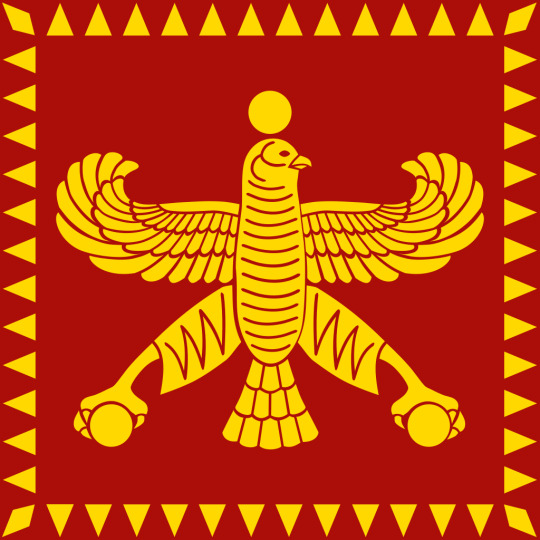
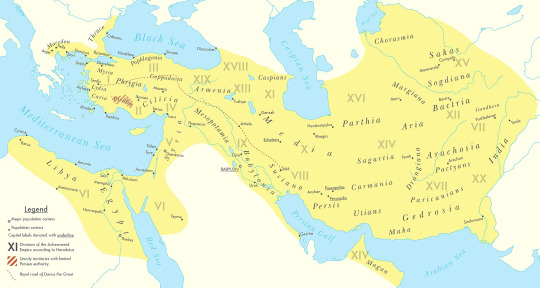

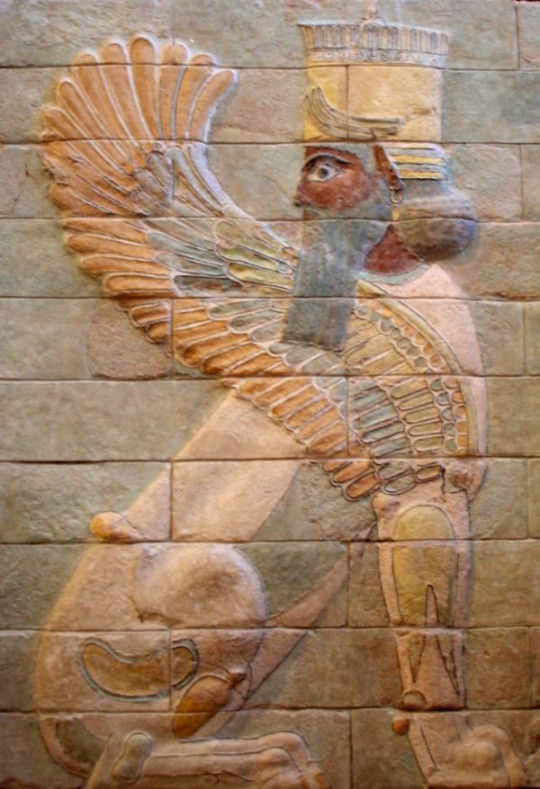


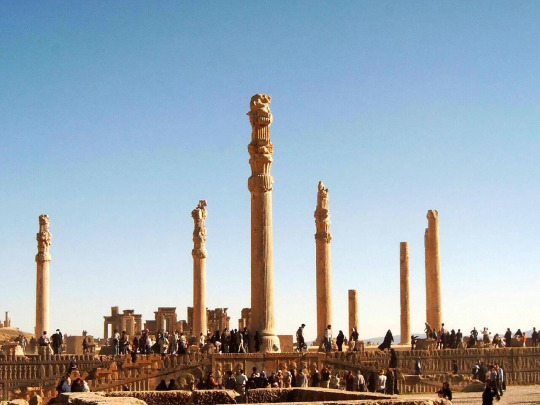
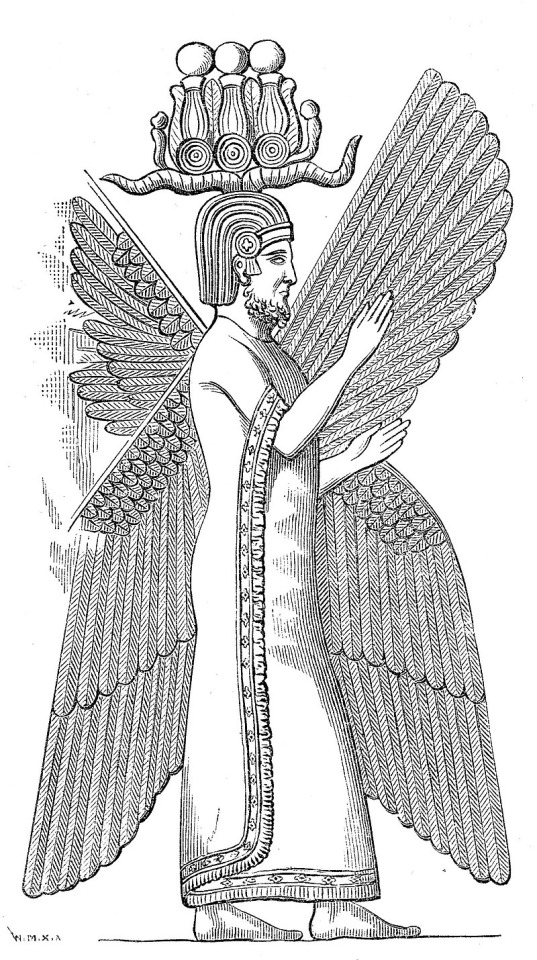
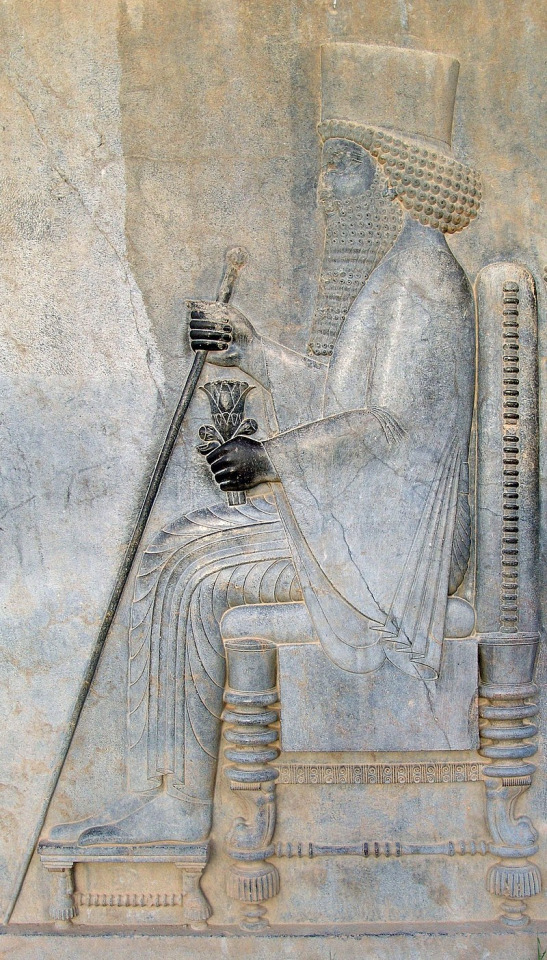


#military history#antiquity#iran#greece#ancient greece#classical greece#ancient ruins#ancient iran#ancient persia#achaemenid#persia#zoroastrianism#alexander the great#cyrus the great#xerxes#artwork#government#history#persian empire#ancient egypt
104 notes
·
View notes